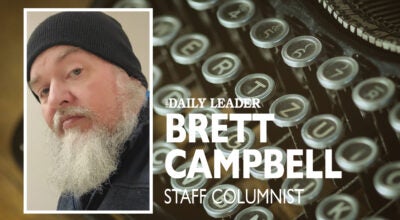Grave words: It’s the hyphen that counts
Published 8:45 am Wednesday, November 9, 2016
I admit it. A couple of months ago my husband and I drove through the Natchez City Cemetery for no other reason than to read tombstones. That’s right. We have a fascination with epitaphs, and it’s commonly acknowledged that the families of the dearly departed in Natchez pen theirs with remarkable style. I guess that’s one reason their cemetery is on the National Register of Historic Places and we weren’t the only ones cruising plots that day. I do, however, think I was the only visitor with a laptop slung over my shoulder. Occasionally, I would lean its screen against a wrought iron gate and type because I could not help myself, the history was so thick in those etchings.
When we left, I tucked a file of 1,043 grave words away in the heart of my computer for the “right time.”
And I figure a day like the day after the most divisive presidential election in history, when it’s important to put things – and ourselves – in perspective, might be a good time to pull it out. That’s because life spans and presidential terms have something significant in common – the hyphen between the beginning and the end of them.
And it’s the hyphen that counts, right?
We found that for some of the markers making up the Natchez cemetery, it was character that defined the hyphen: “The crown of a good name excels all else” (Benjamin Dreyfus, 1867-1914). “Love and charity were the guides of her life” (Mary Briscoe, 1903). “An honest man’s the noblest work of God” (Frederick Read, 1871). “He died beloved, respected and honored by all who knew him” (Duncan Minor, 1862).
For others, it was devotion to a lifework: “Amiable in temper and deportment; vigorous in intellect, considerable in literary attainments, proficient in the science of medicine; he was useful and beloved in life and greatly lamented in death” (Dr. Frederick Seip, 1777-1819). “Pastor of First Presbyterian Church in Natchez for 60 years” (Joseph Stratton 1815-1903). “Erected by his friends and neighbors, a tribute to his worth as a man and in gratitude for his long and faithful services” (John Slicer, MD, 1829-1899). Dr. Slicer is his real name, by the way.
A centuries-gone griever reminded us that the most important job titles don’t always come with a paycheck: “Miss me, but let me go” (Ellen Dyer, homemaker, companion, mother).
Other inscriptions proved that America was the Promised Land to people the world over, including Joseph Buntura (born in Portugal, 1808-1875), David Moses (born in France, 1821-1902), Catherine Schwartz (born in Prussia, 1831-1883) and her husband, Conrad (born in Bavaria, died in Natchez in 1883.) A grand 10-foot marble monument in the Schwartz section of the cemetery attests to the milk and honey part.
Some offered tender tributes, like Natchez Democrat Publisher Warren Koon (1923-1982), who called his wife Martha “The Yellow Rose of Texas,” and then there were the parents of Hugh Roscoe Enochs (1883-1919), who engraved a simple “Our Soldier” on his marble slab.
North of the entrance, a brick crypt testified to the worth of William James (1843-1900), a true family man:
“We miss thee from our home dear, Husband
We miss thee from thy place
A shadow o’ver our life is cast
We miss the sunshine of thy face.
We miss thy kind and willing hand
Thy fond and earnest care
Our home is dark without thee
We miss thee everywhere.”
Elsewhere, lines spoke directly to the tragedies of life, unexpected and early: “Monument erected by the Natchez Drug Co. to the memory of the unfortunate employees who lost their lives in the great disaster that destroyed its building on March 14, 1908.” “Lost in the Mississippi River” (Eugene Benoist, 1929-1969.) “Died in action somewhere near Aachen in Germany” (Louis Benoist, 1921-1945). “Louise. The Unfortunate” (no dates). “Just entering into womanhood, was this young and lovely girl, when suddenly Death with his cold and icy hand came, and destroyed the tender flower” (Jane Ellis, 1844-1860). “He never caused his parents grief but when he died” (James Gustine Minor, 1839-1860).
Perhaps most heart-rending were the tiny headstones, topped by lambs and scattered throughout the one hundred acres, which told of children cherished: “She was lovely; she was fair” (Eliza Winston, 1852-1858). “Infant daughter, sister of Eliza” (born and died May 16, 1859). “She was the light of our home” (another infant).
But wherever we read them, whether describing a life lost in a fire or to a fitful fever or at the age of 105, the epitaphs were grave – almost as grave as verses that say our lifetimes (Psalm 39:4) and our nations (Isaiah 40:17) are as nothing before God.
Visitors to the Natchez cemetery – even recently-elected types – would do well to ponder such things. A memorial bench on the bluff overlooking the Mississippi offers the perfect spot for that kind of contemplation, complete with an American flag flapping in the breeze overhead.
Wesson resident Kim Henderson is a freelance writer who writes for The Daily Leader. Contact her at kimhenderson319@gmail.com.





